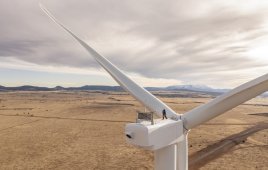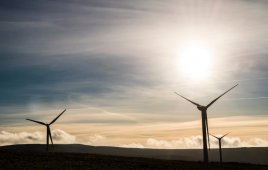Wind power stations do not rest. Vibrations are pervasive. Constant alternating loads with difficult environmental conditions make metals fatigue and wear earlier than in other applications. Despite that, expectations for efficiency continuously increase. To meet such challenges, KTR Corp., Michigan City, Indiana, developed the Radex-N, a steel-laminate coupling for wind turbines. The backlash and maintenance-free coupling uses spring steel laminates that compensate for high displacements and yet allow low restoring forces. The company’s shaft couplings are used in 250 kW to 6-MW wind turbines throughout Europe, Asia, and America.

KTR says its design simplifies assembly in small pods and nacelles because instead of usual large bolts that requiring large tools and high manually generated loads, a Radex-N needs only a conventional-torque sensing screwdriver thanks to special clamping nuts. The necessary prestress on screws comes from a combination of several small screws.
The coupling also provides electric insulation so a current leak cannot get from the generator to the gearbox where it might damage bearings and splines. A positive side effect of the insulating feature is that the total weight is reduced and service simplifies.
Laminates inside the coupling are connected to hub and spacer alternately by means of high-strength shoulder bolts. Apart from the unit’s ability to absorb high misalignments, this combination of engagement and positive locking increases the coupling’s power density.
The company says it developed the steel-laminate packages guided by finite-element analyses. The goal was to find a best design with regard to torque transmission and torsional rigidity, taking into account the necessary displacements.
In addition to couplings, the company offers a frequently needed disk brake that mounts on the gearbox side. The disk, up to 1.5-m dia., includes a sensor for speed monitoring. An overload monitor ensures accurate speed limitation in unfavorable winds.
The Ruflex torque limiter and brake is well suited for its tasks, thanks to friction linings that lets it operate smoothly without stick-slip and with good wear resistance. It is calibrated to a turbine manufacturer’s configuration and built into the coupling spacer. When the equipment senses a max torque, it limits power flow so the turbine is protected against load peaks on the generator side. This also protects the gearbox against high stress and thereby reduces service costs.

KTR also designs combined equipment consisting of coupling, electric separation, brake, sensor disk, and overload devices based on individual components developed for use on wind-power stations. A few recent turbine designs have no gearboxes and so couple the rotor to the generator. These setups make it important to have a powerful overload device to protect against high torque peaks. KTR overload systems provide for the necessary safety on such drives.
To select the right device for an application, the company uses computer-aided torsional vibration analysis, FEM, and tests in company laboratories. The firm can perform tests of service life and load. A climate chamber simulates expected and extreme environmental conditions.
The company says it designed its first coupling for use between a gearbox and generator in 1988. Since then, some 25,000 KTR couplings have been used on windpower stations around the world. The company adds more than 10,000 new applications each year and custom designs are also common requests.
Filed Under: Couplings, Featured, Safety, Turbines




